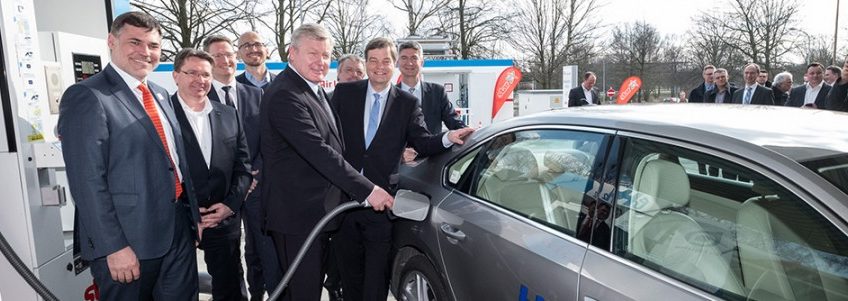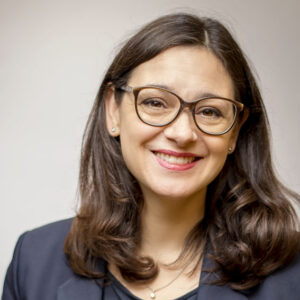CEP partner Air Liquide inaugurates new hydrogen filling station in Wolfsburg First public hydrogen station in Lower Saxony expands the supply network for fuel-cell vehicles in Germany Approximately 900,000 EUR in funding from the Federal Ministry of Transport and Digital Infrastructure (BMVI) under the National Innovation Programme for Hydrogen and Fuel Cell Technology (NIP)
Berlin/ Wolfsburg, 27 March 2018 – Lower Saxony has been officially added to the German hydrogen (H2) map: In the presence of Dr Bernd Althusmann, Minister of Economics, Labour, Transport and Digitisation of the State of Lower Saxony, and Enak Ferlemann, Parliamentary State Secretary to the Federal Minister of Transport and Digital Infrastructure, the CEP partner Air Liquide today officially inaugurated its H2 filling station in Wolfsburg, which has been in operation since August – the first in this German federal state.
The station is one of the first 50 filling stations to be built all over Germany as part of the Clean Energy Partnership (CEP) and with funding from the Federal Ministry of Transport and Digital Infrastructure (BMVI). The construction and operation of the station on Schulenburgallee was supported by the BMVI with around 900,000 EUR. After Mülheim an der Ruhr, Wolfsburg is the second H2 station in Germany that Air Liquide has built in cooperation with Orlen Deutschland/Star-Tankstellen. Its operation will be handled by the joint venture H2 Mobility. Volkswagen, a CEP partner based in Wolfsburg, provided local support for the opening of the H2 station.
Hydrogen-based e-mobility reduces CO2 emissions
The technology behind the hydrogen filling station in Wolfsburg is state-of-the-art, with intuitive handling and a refuelling process similar to that of conventional vehicles: Drivers of fuel-cell vehicles can refuel in Wolfsburg in just three to five minutes, and the average range of the refuelled vehicles exceeds 500 km.
Hydrogen-based electric mobility causes neither pollutants nor CO2 emissions locally. In contrast to battery-powered cars, H2 vehicles generate their own on-board power by reacting hydrogen with air in the fuel cell, thereby generating the electricity that drives the car.
The expansion of the H2 infrastructure in Germany is progressing well. The network already comprises 43 stations, and another 33 filling stations are currently under construction and in planning. By 2018/19, plan is to have 100 stations in place to support the market launch of fuel-cell vehicles. In total, the joint venture H2 Mobility plans to build as many as 400 filling stations in Germany.
Dr Bernd Althusmann, Minister of Economics, Labour, Transport and Digitisation of Lower Saxony:
“Fuel-cell technology and the associated economic potential are of great importance for our federal state. As a location for innovation and science, we aim to make forward-looking investments in the various technologies of the future. We want to establish the future technologies of mobility in Lower Saxony and further expand our leading technological position in automotive engineering. This filling station will be the first step on the successful path of fuel-cell technology here in Lower Saxony.”
Enak Ferlemann, Parliamentary State Secretary to the Federal Minister of Transport and Digital Infrastructure:
“Emissions-free, quiet and highly efficient – hydrogen is one of the energy sources of the future. When it comes to electromobility, we need drivers to feel confident that they can refuel anytime and anywhere. BMVI therefore supports the development of a tank infrastructure for hydrogen/fuel-cell-powered electric vehicles. This is an important key to the market penetration of this technology. The new hydrogen filling station in Wolfsburg is a step in the right direction.”
Günter Lach, Mayor of the City of Wolfsburg:
“I’m very pleased that we are inaugurating Lower Saxony’s first public hydrogen filling station here in Wolfsburg today. Besides the successful collaboration on e-mobility between the city and VW, this demonstrates Wolfsburg’s importance as a major mobility hub and a place where it is worthwhile to test and implement innovative technologies.”
Frédéric Minaud, Managing Director Air Liquide Advanced Technologies GmbH:
“Hydrogen offers a number of benefits for clean transportation. It does not generate any pollution at its point of use: zero greenhouse gases, zero particles, and zero noise. Hydrogen brings a concrete response to the challenges of sustainable mobility and local pollution in urban areas, and contributes to improving air quality in our cities. Air Liquide is committed to the deployment of hydrogen energy, especially for transportation, since 20 years. We are delighted to inaugurate the first hydrogen station installed in the Federal State of Lower Saxony, thus contributing to the construction of the widest network of hydrogen stations in Europe.”
Dr Ulrich Eichhorn, Head of Research and Development at Volkswagen AG:
“To enable sustainable and affordable mobility for many people worldwide, we at Volkswagen focus on the entire drive spectrum, from conventional to purely electric. In the future, we intend to expand our portfolio specifically to include the fuel cell, which we have been researching on for a good 20 years. Just recently, we established a Center of Excellence at Audi where fuel cell technology is to be further developed for the entire Group and brought to market-readiness, initially for small series, in the years ahead. We expect that fuel cell will be a specific form of electromobility in the medium to long term, especially for long distances – after all, a fuel-cell vehicle also runs on electricity, as fuel cells are an electrical energy source that can quickly be recharged with gas.”
Wieslaw Milkiewicz, Managing Director and Press Officer of Orlen Deutschland GmbH and the Star service-station brand:
“We are pleased to be opening the second hydrogen filling station under our existing partnership with Air Liquide. The future holds exciting projects that will diversify the filling station business. We play an active role in shaping this development and are implementing a wide variety of approaches in our “star Connect” filling-station concept.”
Nikolas Iwan, Managing Director H2 Mobility Deutschland GmbH & Co. KG:
“The new Mercedes-Benz GLC F-Cell and Hyundai Nexo models will be available from summer 2018, and the Toyota Mirai has been going from success to success for over a year already, so the number of hydrogen vehicles and models is on a steady increase. At the same time, we are expanding the network. Hydrogen is coming, because it is winning over more and more companies and individuals by providing the usual convenience, long ranges, and short refuelling times with clean electric mobility.”
The Clean Energy Partnership (CEP) industry partnership is working on the market establishment and systems compatibility of hydrogen and fuel-cell mobility, in the interests of a sustainable energy shift. Air Liquide, Audi, BMW, Daimler, H2 Mobility, Honda, Hyundai, Linde, OMV, Shell, Total, Toyota and the Westfalen Group are involved in the project.
www.cleanenergypartnership.de
H2 Mobility, a company founded by CEP partners, whose shareholders are Air Liquide, Daimler, Linde, OMV, Shell and Total, is responsible for the expansion of the hydrogen infrastructure throughout Germany. BMW, Honda, Hyundai, Toyota, Volkswagen, and NOW GmbH advise H2 Mobility as associated partners. The H2.LIVE app lets you follow how the filling station network is growing.
www.h2.live
The National Organisation for Hydrogen and Fuel Cell Technology (NOW GmbH) coordinates funding programmes for the development of battery and fuel-cell electromobility on behalf of the German government.


